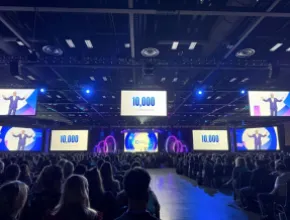Trying to pin down what technology trends are impacting the meetings industry can be a tricky proposition. After all, are we talking specifically for the meetings industry or branching out to travel tech and general productivity tools?
Yes to all three, it turns out. And it’s about platforms, in addition to software, too.
“The conversation begins with mobile devices, in terms of practical new technology,” says meetings industry technology speaker James Spellos, president of Meeting U. “[Attendees] are coming to meetings with mobile devices, be it tablets or smart phones.”
“Augmented reality,” basically wearable hardware such as Google Glass that lets you see things with your own eyes but layers it with additional information, is another technology that should make its way into the meetings experience in the future, albeit it’s a bit far out on the horizon.
Spellos says that three-dimensional printing, which would allow for suppliers and others to instantly “print” customized items, say, on a trade show floor, and geofencing, which allows businesses such as hotels to draw a perimeter “fence” and send out push notifications for special events and other information, are two big advances that are set to make an impact.
“Once the tool is out there it becomes a matter of one’s creativity to say ‘I have a better way of using it,’” Spellos says. “Then that becomes the killer tool, the killer app.”
New devices, and the ability to compute on the go, is the tip of an iceberg that may transform the very way we interact with the world, above and far beyond merely meetings and events.
“It seems that major technology trends go in 10-year cycles,” says fellow meetings industry tech expert, consultant and speaker Corbin Ball, president of Corbin Ball Associates. “In the ’60s it was mainframe computers. In the ’70s it was mini-computers. In the ’80s, personal computers. In the ’90s, desktop Internet computing. In the 2000s, mobile Internet computing. Next is ‘everywhere’ computing and wearable computing, so you’re going to see a lot more devices.”
Ball says that more and more everyday items such as refrigerators and thermostats will have their own IP address and will be controllable from a mobile phone. Smart watches and bio sensors are also coming down the pike. Image-based, rather than text-based, searching in which a user can point a device at an object or storefront and get further information, along with facial-recognition software, are other technologies that may greatly shape how people interact in their environment. PageBreak
Meetings Applications
The fact that any discussion about meetings technology quickly evolves into a conversation about technology in general is just the point; technology converges on the meetings industry in a variety of ways, both intended and unintended.
“The problem is we’re looking to the wrong place for our solutions,” says Spellos when asked about what meetings technologies are shaping the meetings industry. “We keep looking within our own industry for apps created for us when there are so many apps out there that are very useful, but not just for meetings.”
Spellos points to general sharing and productivity apps such as Dropbox, Evernote and the many cloud storage options as examples of utilitarian tools planners can use to boost meetings efficiency.
One such tool can be borrowed from the construction and design industry, Point & Measure, with which planners can use a smart phone to get the dimensions of a prospective function room on the fly.
Spellos recommends using Google Drive for all contracts and small-scale surveys, and Dropbox as a virtual three-ring binder for a conference.
“I don’t think planners and suppliers should wait for the killer meetings app,” he says. “It may happen, but do you really want to wait, with all this other stuff around?”
Corbin Ball says many apps develop out into what he calls “Swiss Army Apps,” in that a large range of services are available within a single app, rather than users having to download a slew of different apps.
“I think the trend is really going to go to the ‘Swiss Army’ approach,” he says, mentioning apps such as Bizzaboo, a mobile networking app specifically made for events and conferences that allows planners to leverage social media, attendee communication, marketing and analysis. “It’s free, and they focus a lot on social media, but you can actually run fairly complex meetings with that, including conference agendas.”
Others, such as OleaPark, Qrios and Shhmooze also use a social media interface to connect and network with contacts at events, which is one of the primary objectives of many meetings.
“Good contacts at an event can pay for an entire event,” Ball says. “We’ve been doing it the same way for years—with name badges. You can do it so much better with technology, so that’s where these tools come in to do that.”
Other recent non-meetings-specific apps that interest Ball include “life-logging” apps such as Saga, which captures a record of everywhere a user ventures.
More information on cutting-edge event apps can be found via Ball’s latest TechTalk newsletter. PageBreak
The Nitty-Gritty
Aside from prognosticating about coming technology that will impact the meetings industry, both Spellos and Ball believe there are a few core tech issues that planners should concentrate on in the here and now.
“The 600-pound gorilla is Wi-Fi and the two prongs that come with it: costs and bandwidth,” Spellos contends. “Fewer and fewer meetings can be sustained without having adequate Wi-Fi. Our industry is still fumbling—it’s the Wild West out there. Planners need to know about it or be forced to pay for it, and then, at the point of negotiation, the price becomes much higher.”
Spellos adds that the coming preeminence of Web browsers is the real story.
“I think the whole game is browser-based functionality,” he says. “Clearly the browser is our future OS [operating system]. I think we’re getting to a ‘smaller is more efficient’ standpoint of technology. It’s not whether we want to use an HP or a Dell, but Chrome or Firefox.”
Ball maintains that having responsive Web design that recognizes various browser resolutions (i.e, desktop, tablet or smart phone) is becoming increasingly crucial.
“Tablets are outselling laptops now,” Ball says, “so it really emphasizes the need that your website is going to have to adapt to a variety of screen sizes. The website is still going to be a vital information piece, but it needs to be in a variety of formats.”







